Feng Yang
DeCoP: Enhancing Self-Supervised Time Series Representation with Dependency Controlled Pre-training
Sep 18, 2025Abstract:Modeling dynamic temporal dependencies is a critical challenge in time series pre-training, which evolve due to distribution shifts and multi-scale patterns. This temporal variability severely impairs the generalization of pre-trained models to downstream tasks. Existing frameworks fail to capture the complex interactions of short- and long-term dependencies, making them susceptible to spurious correlations that degrade generalization. To address these limitations, we propose DeCoP, a Dependency Controlled Pre-training framework that explicitly models dynamic, multi-scale dependencies by simulating evolving inter-patch dependencies. At the input level, DeCoP introduces Instance-wise Patch Normalization (IPN) to mitigate distributional shifts while preserving the unique characteristics of each patch, creating a robust foundation for representation learning. At the latent level, a hierarchical Dependency Controlled Learning (DCL) strategy explicitly models inter-patch dependencies across multiple temporal scales, with an Instance-level Contrastive Module (ICM) enhances global generalization by learning instance-discriminative representations from time-invariant positive pairs. DeCoP achieves state-of-the-art results on ten datasets with lower computing resources, improving MSE by 3% on ETTh1 over PatchTST using only 37% of the FLOPs.
ICDM: Interference Cancellation Diffusion Models for Wireless Semantic Communications
May 26, 2025Abstract:Diffusion models (DMs) have recently achieved significant success in wireless communications systems due to their denoising capabilities. The broadcast nature of wireless signals makes them susceptible not only to Gaussian noise, but also to unaware interference. This raises the question of whether DMs can effectively mitigate interference in wireless semantic communication systems. In this paper, we model the interference cancellation problem as a maximum a posteriori (MAP) problem over the joint posterior probability of the signal and interference, and theoretically prove that the solution provides excellent estimates for the signal and interference. To solve this problem, we develop an interference cancellation diffusion model (ICDM), which decomposes the joint posterior into independent prior probabilities of the signal and interference, along with the channel transition probablity. The log-gradients of these distributions at each time step are learned separately by DMs and accurately estimated through deriving. ICDM further integrates these gradients with advanced numerical iteration method, achieving accurate and rapid interference cancellation. Extensive experiments demonstrate that ICDM significantly reduces the mean square error (MSE) and enhances perceptual quality compared to schemes without ICDM. For example, on the CelebA dataset under the Rayleigh fading channel with a signal-to-noise ratio (SNR) of $20$ dB and signal to interference plus noise ratio (SINR) of 0 dB, ICDM reduces the MSE by 4.54 dB and improves the learned perceptual image patch similarity (LPIPS) by 2.47 dB.
Bridging Geometry-Coherent Text-to-3D Generation with Multi-View Diffusion Priors and Gaussian Splatting
May 07, 2025
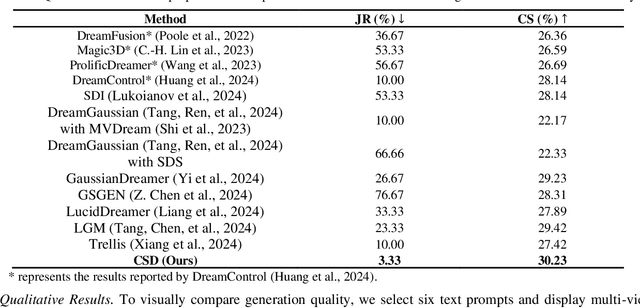
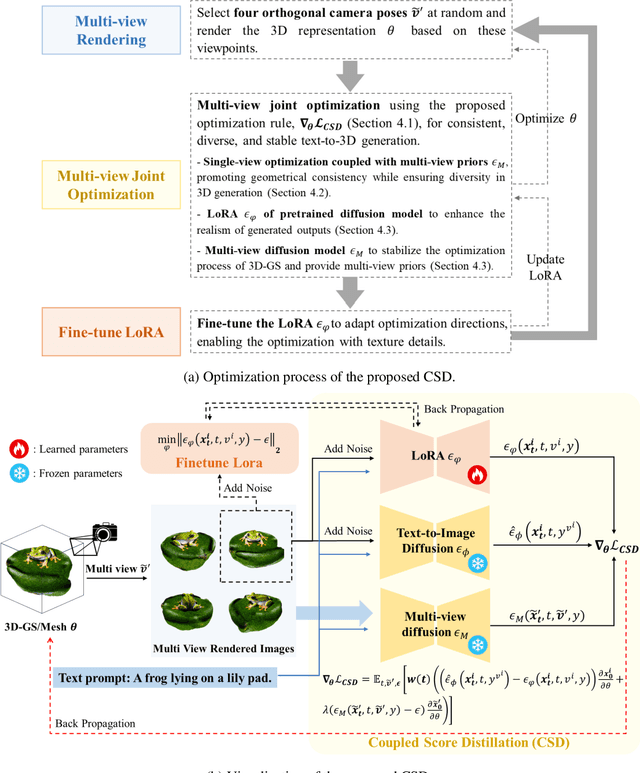
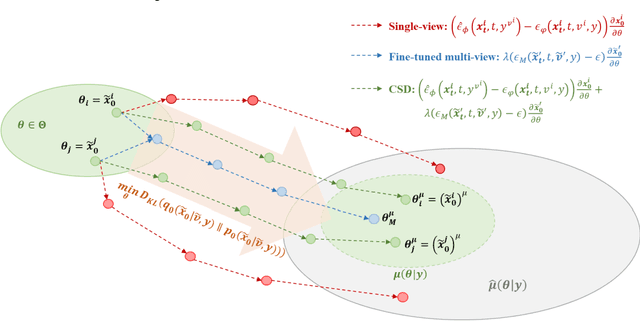
Abstract:Score Distillation Sampling (SDS) leverages pretrained 2D diffusion models to advance text-to-3D generation but neglects multi-view correlations, being prone to geometric inconsistencies and multi-face artifacts in the generated 3D content. In this work, we propose Coupled Score Distillation (CSD), a framework that couples multi-view joint distribution priors to ensure geometrically consistent 3D generation while enabling the stable and direct optimization of 3D Gaussian Splatting. Specifically, by reformulating the optimization as a multi-view joint optimization problem, we derive an effective optimization rule that effectively couples multi-view priors to guide optimization across different viewpoints while preserving the diversity of generated 3D assets. Additionally, we propose a framework that directly optimizes 3D Gaussian Splatting (3D-GS) with random initialization to generate geometrically consistent 3D content. We further employ a deformable tetrahedral grid, initialized from 3D-GS and refined through CSD, to produce high-quality, refined meshes. Quantitative and qualitative experimental results demonstrate the efficiency and competitive quality of our approach.
Dual-Branch Residual Network for Cross-Domain Few-Shot Hyperspectral Image Classification with Refined Prototype
Apr 27, 2025Abstract:Convolutional neural networks (CNNs) are effective for hyperspectral image (HSI) classification, but their 3D convolutional structures introduce high computational costs and limited generalization in few-shot scenarios. Domain shifts caused by sensor differences and environmental variations further hinder cross-dataset adaptability. Metric-based few-shot learning (FSL) prototype networks mitigate this problem, yet their performance is sensitive to prototype quality, especially with limited samples. To overcome these challenges, a dual-branch residual network that integrates spatial and spectral features via parallel branches is proposed in this letter. Additionally, more robust refined prototypes are obtained through a regulation term. Furthermore, a kernel probability matching strategy aligns source and target domain features, alleviating domain shift. Experiments on four publicly available HSI datasets illustrate that the proposal achieves superior performance compared to other methods.
OpenDriveVLA: Towards End-to-end Autonomous Driving with Large Vision Language Action Model
Mar 30, 2025Abstract:We present OpenDriveVLA, a Vision-Language Action (VLA) model designed for end-to-end autonomous driving. OpenDriveVLA builds upon open-source pre-trained large Vision-Language Models (VLMs) to generate reliable driving actions, conditioned on 3D environmental perception, ego vehicle states, and driver commands. To bridge the modality gap between driving visual representations and language embeddings, we propose a hierarchical vision-language alignment process, projecting both 2D and 3D structured visual tokens into a unified semantic space. Besides, OpenDriveVLA models the dynamic relationships between the ego vehicle, surrounding agents, and static road elements through an autoregressive agent-env-ego interaction process, ensuring both spatially and behaviorally informed trajectory planning. Extensive experiments on the nuScenes dataset demonstrate that OpenDriveVLA achieves state-of-the-art results across open-loop trajectory planning and driving-related question-answering tasks. Qualitative analyses further illustrate OpenDriveVLA's superior capability to follow high-level driving commands and robustly generate trajectories under challenging scenarios, highlighting its potential for next-generation end-to-end autonomous driving. We will release our code to facilitate further research in this domain.
Calibrated Multi-Preference Optimization for Aligning Diffusion Models
Feb 04, 2025Abstract:Aligning text-to-image (T2I) diffusion models with preference optimization is valuable for human-annotated datasets, but the heavy cost of manual data collection limits scalability. Using reward models offers an alternative, however, current preference optimization methods fall short in exploiting the rich information, as they only consider pairwise preference distribution. Furthermore, they lack generalization to multi-preference scenarios and struggle to handle inconsistencies between rewards. To address this, we present Calibrated Preference Optimization (CaPO), a novel method to align T2I diffusion models by incorporating the general preference from multiple reward models without human annotated data. The core of our approach involves a reward calibration method to approximate the general preference by computing the expected win-rate against the samples generated by the pretrained models. Additionally, we propose a frontier-based pair selection method that effectively manages the multi-preference distribution by selecting pairs from Pareto frontiers. Finally, we use regression loss to fine-tune diffusion models to match the difference between calibrated rewards of a selected pair. Experimental results show that CaPO consistently outperforms prior methods, such as Direct Preference Optimization (DPO), in both single and multi-reward settings validated by evaluation on T2I benchmarks, including GenEval and T2I-Compbench.
Psychometric-Based Evaluation for Theorem Proving with Large Language Models
Feb 02, 2025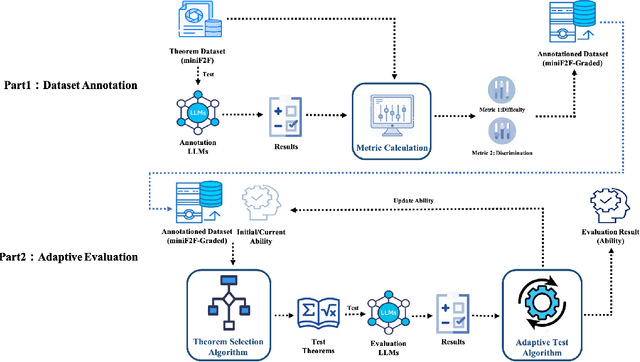

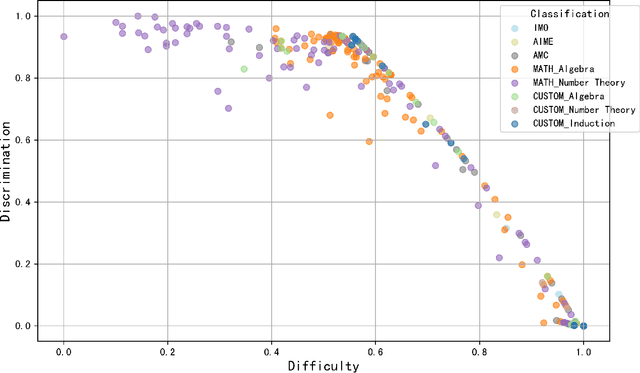

Abstract:Large language models (LLMs) for formal theorem proving have become a prominent research focus. At present, the proving ability of these LLMs is mainly evaluated through proof pass rates on datasets such as miniF2F. However, this evaluation method overlooks the varying importance of theorems. As a result, it fails to highlight the real performance disparities between LLMs and leads to high evaluation costs. This study proposes a psychometric-based evaluation method for theorem proving with LLMs, comprising two main components: Dataset Annotation and Adaptive Evaluation. First, we propose a metric calculation method to annotate the dataset with difficulty and discrimination metrics. Specifically, we annotate each theorem in the miniF2F dataset and grade them into varying difficulty levels according to the performance of LLMs, resulting in an enhanced dataset: miniF2F-Graded. Experimental results show that the difficulty grading in miniF2F-Graded better reflects the theorem difficulty perceived by LLMs. Secondly, we design an adaptive evaluation method to dynamically select the most suitable theorems for testing based on the annotated metrics and the real-time performance of LLMs. We apply this method to evaluate 10 LLMs. The results show that our method finely highlights the performance disparities between LLMs. It also reduces evaluation costs by using only 23% of the theorems in the dataset.
Focus-N-Fix: Region-Aware Fine-Tuning for Text-to-Image Generation
Jan 11, 2025Abstract:Text-to-image (T2I) generation has made significant advances in recent years, but challenges still remain in the generation of perceptual artifacts, misalignment with complex prompts, and safety. The prevailing approach to address these issues involves collecting human feedback on generated images, training reward models to estimate human feedback, and then fine-tuning T2I models based on the reward models to align them with human preferences. However, while existing reward fine-tuning methods can produce images with higher rewards, they may change model behavior in unexpected ways. For example, fine-tuning for one quality aspect (e.g., safety) may degrade other aspects (e.g., prompt alignment), or may lead to reward hacking (e.g., finding a way to increase rewards without having the intended effect). In this paper, we propose Focus-N-Fix, a region-aware fine-tuning method that trains models to correct only previously problematic image regions. The resulting fine-tuned model generates images with the same high-level structure as the original model but shows significant improvements in regions where the original model was deficient in safety (over-sexualization and violence), plausibility, or other criteria. Our experiments demonstrate that Focus-N-Fix improves these localized quality aspects with little or no degradation to others and typically imperceptible changes in the rest of the image. Disclaimer: This paper contains images that may be overly sexual, violent, offensive, or harmful.
HV-BEV: Decoupling Horizontal and Vertical Feature Sampling for Multi-View 3D Object Detection
Dec 25, 2024



Abstract:The application of vision-based multi-view environmental perception system has been increasingly recognized in autonomous driving technology, especially the BEV-based models. Current state-of-the-art solutions primarily encode image features from each camera view into the BEV space through explicit or implicit depth prediction. However, these methods often focus on improving the accuracy of projecting 2D features into corresponding depth regions, while overlooking the highly structured information of real-world objects and the varying height distributions of objects across different scenes. In this work, we propose HV-BEV, a novel approach that decouples feature sampling in the BEV grid queries paradigm into horizontal feature aggregation and vertical adaptive height-aware reference point sampling, aiming to improve both the aggregation of objects' complete information and generalization to diverse road environments. Specifically, we construct a learnable graph structure in the horizontal plane aligned with the ground for 3D reference points, reinforcing the association of the same instance across different BEV grids, especially when the instance spans multiple image views around the vehicle. Additionally, instead of relying on uniform sampling within a fixed height range, we introduce a height-aware module that incorporates historical information, enabling the reference points to adaptively focus on the varying heights at which objects appear in different scenes. Extensive experiments validate the effectiveness of our proposed method, demonstrating its superior performance over the baseline across the nuScenes dataset. Moreover, our best-performing model achieves a remarkable 50.5% mAP and 59.8% NDS on the nuScenes testing set.
LVMark: Robust Watermark for latent video diffusion models
Dec 12, 2024Abstract:Rapid advancements in generative models have made it possible to create hyper-realistic videos. As their applicability increases, their unauthorized use has raised significant concerns, leading to the growing demand for techniques to protect the ownership of the generative model itself. While existing watermarking methods effectively embed watermarks into image-generative models, they fail to account for temporal information, resulting in poor performance when applied to video-generative models. To address this issue, we introduce a novel watermarking method called LVMark, which embeds watermarks into video diffusion models. A key component of LVMark is a selective weight modulation strategy that efficiently embeds watermark messages into the video diffusion model while preserving the quality of the generated videos. To accurately decode messages in the presence of malicious attacks, we design a watermark decoder that leverages spatio-temporal information in the 3D wavelet domain through a cross-attention module. To the best of our knowledge, our approach is the first to highlight the potential of video-generative model watermarking as a valuable tool for enhancing the effectiveness of ownership protection in video-generative models.
 Add to Chrome
Add to Chrome Add to Firefox
Add to Firefox Add to Edge
Add to Edge